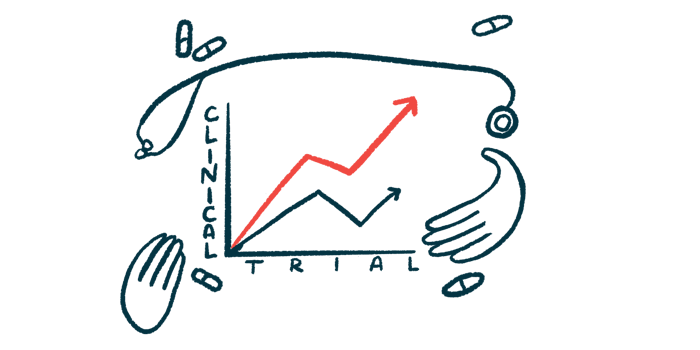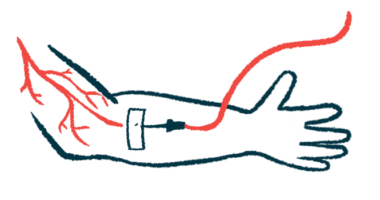Tavneos combo works as well as steroids for AAV remission
Therapy plus cyclophosphamide found effective in trial, with fewer side effects

Similar rates of remission and sustained remission were found for people with ANCA-associated vasculitis (AAV) given induction treatment with cyclophosphamide and Tavneos (avacopan) in a clinical trial compared with those receiving cyclophosphamide plus the glucocorticoid prednisone.
Still, the Tavneos-based treatment regimen appeared to be associated with a lower relapse rate, faster kidney recovery, and reduced glucocorticoid toxicity, according to the results of a post hoc analysis of the Phase 3 ADVOCATE clinical trial (NCT02994927). A post hoc analysis is specified and carried out after the study is complete and all the data have been collected.
In noting “what this study adds,” the researchers wrote that, compared with the use of prednisone, Tavneos was “associated with improved kidney function, less glucocorticoid-related toxicity and fewer relapses.” The team added that “overall safety outcomes were similar in both groups.”
While considered a standard AAV treatment, glucocorticoids like prednisone are associated with serious adverse events when used at high doses or for a long time.
The study, titled “Efficacy and safety of avacopan for treatment of patients with ANCA-associated vasculitis receiving cyclophosphamide,” was published in the journal RMD Open. The work was funded by ChemoCentryx, Tavneos’ original developer, which was later acquired by Amgen.
AAV comprises a group of conditions marked by inflammation and damage to small blood vessels. Standard treatment to induce AAV remission typically involves high-dose glucocorticoids combined with either rituximab or cyclophosphamide, two immunosuppressive medications administered intravenously, or directly into the bloodstream.
ADVOCATE trial data supported approval of Tavneos for AAV
Tavneos is an oral medication approved as an add-on to standard treatment for adults with severe and active microscopic polyangiitis (MPA) or granulomatosis with polyangiitis (GPA) — the two most common types of AAV. It works by lowering AAV-driving inflammation through the suppression of an immune protein known as the C5a receptor.
The therapy’s approvals were based mainly on data from the ADVOCATE trial, which tested Tavneos against a high prednisone dose in 330 individuals with GPA and MPA on standard induction treatment.
The results demonstrated that one year of Tavneos was better than prednisone at inducing long-term remission and improving kidney function and quality of life among patients. It also helped to reduce glucocorticoid use.
A previous subgroup analysis of ADVOCATE participants who were on rituximab showed that Tavneos was superior to prednisone as a taper treatment in sustaining remission for one year.
Because cyclophosphamide “continues to be used in practice, especially when response to [rituximab] is inadequate or access to [the therapy] is limited, and as [Tavneos] availability broadens, it is important to understand the efficacy and safety of concurrent use of [cyclophosphamide] and [Tavneos],” the scientists wrote.
To that end, a research team from the U.S. and Europe now conducted a subgroup analysis of ADVOCATE that focused only on the 116 participants who were given cyclophosphamid. Among them, 59 were treated with Tavneos and 57 were given the prednisone taper.
This patient group had a mean age of 62.7, and slightly more than 6 in every 10 were male. Most (84%) were white individuals. Slightly more than half (55%) had MPA, and kidney involvement was found in 91%. Of the patients, 90% were newly diagnosed with AAV.
At study’s start, demographic and clinical features among patients given cyclophosphamide “were similar between the two treatment groups and did not differ appreciably from those of the entire ADVOCATE study population,” the researchers wrote.
More relapses seen for patients on prednisone combo
The results showed that rates of disease remission were similar between the Tavneos and prednisone groups after six months (62.7% vs. 59.6%), as well as after one year of treatment — which is then classified as sustained remission (55.9% vs. 52.6%).
Among participants who achieved disease remission, 13% of those on Tavneos experienced a disease relapse during the study, compared with 23% of those on prednisone. While this suggested a 47% lower risk of relapse with Tavneos, this difference did not reach statistical significance.
In the group of patients with kidney involvement, both treatments resulted in improvements in kidney function. However, these gains were numerically greater in the Tavneos group, including among participants with severe loss of kidney function.
These observations support the key role of [Tavneos] in combination with [cyclophosphamide] in achieving rapid and sustained improvement in kidney function compared with a prednisone taper.
Tavneos was also associated with signs of earlier kidney function recovery, including a faster reduction in proteinuria, or excess protein in urine — a key marker of kidney damage — within the first month of treatment. After one year, both treatment groups showed a reduction of more than 75% in proteinuria.
“These observations support the key role of [Tavneos] in combination with [cyclophosphamide] in achieving rapid and sustained improvement in kidney function compared with a prednisone taper,” the researchers wrote.
In addition, glucocorticoid use was numerically lower in the Tavneos group, as was glucocorticoid-associated toxicity, measured using the Glucocorticoid Toxicity Index.
People on Tavneos also appeared to be less likely to need additional nonglucocorticoid immunosuppressive medications relative to those in the prednisone taper group. During the one-year study, 16.9% of Tavneos-treated patients required additional medications compared with 24.6% of those in the prednisone group.
Measures of health-related quality of life showed improvements with both treatments, but these were generally greater with Tavneos.
The proportion of participants experiencing serious adverse events and serious infections was similar between the two treatment groups, the researchers noted.
Overall, “these results support the use of [Tavneos] in combination with [cyclophosphamide] to treat GPA or MPA,” the team concluded.








